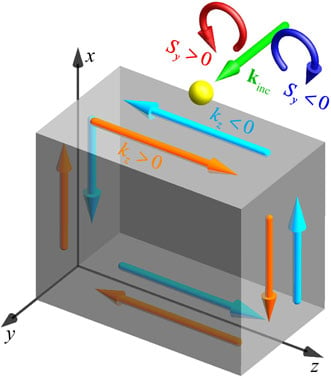The spin of incident light determines the direction of propagation of evanescent waves along a surface, according to researchers at the Riken Center for Emergent Matter Science.
The finding demonstrates that the quantum spin Hall effect, already well known in electrons, is also an intrinsic property of photons, the researchers said.
"On a purely scientific level, this research deepens our understanding of the classical theory of light waves, developed by James Clerk Maxwell 150 years ago, and it could also lead to applications using optical devices that are based on the direction of spin," said lead researcher Konstantin Bliokh.

Schematic of experiments demonstrating the quantum spin Hall effect of light. The incident Y-propagating light (shown in green) is coupled to surface modes with evanescent free-space tails via a scatterer (e.g., a nanoparticle). Surface waves with opposite propagation directions are excited depending on the spin of the incident light. Courtesy of Riken.
Photons have neither mass nor charge and so behave very differently from their massive counterparts. But they do share the property of spin, or intrinsic angular momentum, which results in remarkable geometric and topological phenomena.
"We had previously done work looking at evanescent electromagnetic waves," Bliokh said, "and we realized the remarkable property we found, an unusual transverse spin, was a manifestation of the fact that free-space light exhibits an intrinsic quantum spin Hall effect, meaning that evanescent waves with opposite spins will travel in opposite directions along an interface between two media."
Evanescent waves propagate along the surface of materials such as metals at the interface with a vacuum and they decay exponentially as they move away from the interface.
The quantum spin Hall effect in electrons enables the existence of an unusual type of material — a topological insulator — that conducts electricity on the surface but not through the bulk of the material.
Although light does not propagate through metals, it is known that it can propagate along interfaces between metal and vacuum in the form of surface plasmons involving evanescent light waves. The researchers showed that the unusual transverse spin they found in evanescent waves was caused by the intrinsic quantum Hall effect of photons.
They said the findings also explain recent experiments that have shown spin-controlled unidirectional propagation of surface optical modes.
The research was published in Science (doi: 10.1126/science.aaa9519).
For more information, visit www.riken.jp.